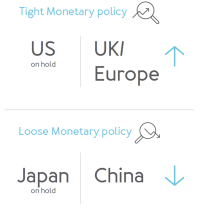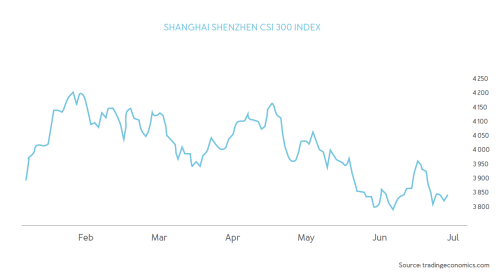Market commentary
AI Sparked the Biggest Tech Rally in Two Decades Despite Sticky Inflation | Q2 2023

Too early to declare victory over inflation
Following 10 consecutive hikes over an 18-month period and ending an intense quarter of central bank actions, the US Federal Reserve opted to leave interest rates unchanged at between 5% and 5.25%. It remains unwavering, however, in its commitment to bringing inflation down to its 2% target and indicated further hikes would likely be needed to achieve this.
On the contrary, counterparts in the European Union and the United Kingdom maintained their tightening policy by pushing up interest rates. Ironically, whilst central banks globally have been ‘fighting inflation’ over the past year, it has been welcomed by Japan’s policymakers. Following decades of deflation, the country’s consumer prices rose in January at the fastest annual pace in 41 years. Inflation has since slowed a little but remains well above the Bank of Japan’s 2% target (3.4% in April). Despite this, the central bank has kept its main interest rate below zero. Also, at odds with policies in the West, the central bank in China cut interest rates to stimulate the struggling economy.
Locally, the Monetary Policy Committee (MPC) hiked interest rates by another 50bps in May, bringing the policy rate to 8.25%. The MPC now views policy to be ‘restrictive’ (hurting the economy) instead of ‘less accommodative’, an acknowledgement that the current policy setting should not only dampen activity but constrain it. It also suggests that the MPC is becoming more confident that the current level of interest rates can pull inflation back to target. Having witnessed 475bps of hikes implemented in less than two years, the continued uncertainty is worrying, leaving the door open for possible future interest rate hikes.

Global markets driven by AI
Entering 2023, investors had concerns over a beaten-down tech sector, geopolitical risks relating to the war in Ukraine, the debt ceiling limit, higher inflation, rising interest rates and a regional banking crisis in the US.
Despite these concerns, we saw a massive rally in US tech stocks. This has been all about future potential – driven by the excitement around artificial intelligence (AI) – rather than anything to do with fundamentals. Extracting tech from the rest of the market would provide a more realistic scenario in which the macro conditions indicate what will drive share performance over the next six months.
Overall, the MSCI AC World Index is up 12.8% YTD – led by US technology and Japanese stocks, and the S&P 500 Index is up almost 16% YTD. However, emerging markets have underperformed developed markets – the MSCI Emerging Markets (EM) Index has gained only 3.5% YTD, mainly due to the poor performance of the Chinese stock market, which makes up approximately 30% of the EM index.
US Tech Rally
Evident by the tech price actions thus far, Wall Street is bent on fooling the masses. It is not clear whether the stock market is getting the message regarding higher-for-longer interest rates – it has climbed the proverbial ‘Wall of Worry’ with extraordinary returns. After the beatdown that tech stocks endured in 2022, few anticipated returns of nearly 32% YTD from the Nasdaq Composite. The market is clearly ‘love-struck’ by artificial intelligence (AI).
The “Magnificent Seven,” as Wall Street likes to label them – Amazon (55%), Alphabet (36%), Apple (49%), Tesla (112%), Microsoft (42%), Meta (138%) and Nvidia (189%) – are responsible for driving this rally. In fact, in the NASDAQ 100, more than 80% of the gains year-to-date can be attributed to the Magnificent Seven, in reference to the western film, The Magnificent Seven, that was released in the 1960’s.
“The development of AI is as fundamental as the creation of the microprocessor, the personal computer, the Internet, and the mobile phone”. – Bill Gates
Nvidia in pole position
An investor craze for artificial intelligence has powered Nvidia’s spectacular rise and pushed the share to lofty valuations, gaining almost 200% YTD. Interestingly, Nvidia do not have their own plants. They are strictly an engineering and marketing company that relies 100% on producing their chips in Taiwanese semiconductor manufacturing facilities.
The share price rise provides Nvidia with a market valuation of more than $1 trillion, something that only a handful of publicly traded companies have achieved. Apple was first valued at $1 trillion in 2018 and then reaching a $3 trillion valuation in 2022 and again in June 2023.
Pretty much all the major chip producers have a focus on AI, including Intel. Manufacturers have existing chips, that have been used for other sources, but not AI. Although they are now being recast as AI chips, Nvidia has a very specific chip that is used in AI. Hence, if we look at the field right now in the AI chip space, Nvidia is leading the pack, with everyone else trying to play catch up.
Nvidia also unveiled a new batch of products and services tied to artificial intelligence. The wide-ranging lineup includes a new robotics design, gaming capabilities, advertising services and networking technology, as well as an AI supercomputer platform called DGX GH200. The DGX computer is another attempt to keep data center operators hooked on Nvidia’s products. Microsoft, Google and their peers are all racing to develop services similar to OpenAI Inc.’s ChatGPT chatbot – and that requires plenty of computing horsepower. To satisfy this appetite, Nvidia is both offering equipment for data centers and building its own supercomputers that customers can use, including two new supercomputers in Taiwan.
Nvidia is teaming up with WPP Plc to use AI and the metaverse to lower the cost of producing advertising. They are even looking to change how people interact with video games – a service called Nvidia ACE for Games will use AI to enliven background characters and give them more personality.
“To realize the full potential of AI, customers are increasingly turning to accelerated computing and graphics processing units, or GPUs”. – Jensen Huang, CEO of Nvidia
Japan…is it different this time around?
The Japanese equities market has had many false dawns over the past three decades – and counting – since the economic bubble burst. More than once, bull markets have arrived only to quietly fade out. Will it be different this time around? The Nikkei 225 Stock Average closed Q2 at the highest level since 1990, up 27% YTD and some are once again asking if this time they can finally topple the high watermark achieved on the last trading day of 1989.
Japanese stocks have benefitted from a revolution
in corporate governance that has steadily changed the focus of management. Shareholder returns have become part of the mandate, resulting in quarter after quarter of large-scale share buybacks and dividend increases. Stocks also benefitted from relatively cheap valuations, a long-awaited return of inflation, and a weakening currency, on the back of prolonged looser monetary policy. A weaker currency makes the country’s exports relatively cheaper on the world market, which is a big benefit for a major exporting nation such as Japan.
Interestingly, Socionext Inc., a small Japanese chip design firm, has jumped more than 248% this year in Japanese yen terms, making it the best-
performing stock on the Topix Index. Socionext develops and produces chips only after receiving orders and hence, has a fundamentally different business model from industry leaders Nvidia and Advanced Micro Devices Inc.

China is lagging…investors frustrated
China’s waning economic recovery, the weakness of the yuan, and geopolitical tensions with the US have become a source of frustration for those who issued bullish calls in the wake of the nation’s reopening. Some are already stepping back after the CSI 300 Index – a benchmark of onshore Chinese stocks – wiped out all its early year gains. YTD, the CSI 300 Index is ‘flat’ – up only 0.5%.
While investors will likely welcome further efforts by Chinese authorities to support the economy, much will hinge on the ultimate makeup of the stimulus measures. The muted market reaction to the central bank’s reverse repo rate cut and 10 basis points cut of its 1-year Medium-Term Lending Facility (MTLF) loans to 2.65%, underscored mounting scepticism that monetary policy alone can reinvigorate an economy weighed down by record debt levels (notably the shaky property market), waning global demand, and weak investor confidence distressed by years of unpredictable policy changes.
Local Markets
The sentiment towards risk assets remains decidedly negative as the domestic economy wrestles with load-shedding, high interest rates and massive unemployment. This is expected to begin impacting meaningfully on economic growth and by extension, the ability of businesses to grow. In June, Mr Price – often considered the bellwether of the retail sector – posted a fall of 6% in annual profit on the back of increased inflationary pressure on consumers and power cuts. It is easy to blame the overall negative sentiment, but commodity prices have also been weak – platinum and palladium are down 16% and 31% respectively YTD, weighing on resource shares, despite the weaker rand.
The JSE All Share Index, which includes large international dual-listed stocks, has returned only 4% YTD, after a flat Q2. Like US tech stocks driving global returns, we have seen a handful of big index rand hedge stocks – Richemont (up 44%), Naspers (up 20%) and Prosus (up 17%) – keeping the local equity market ‘afloat’ YTD. The biggest drag has been resources which lost 12%. Anglos was down 19% and Anglo Platinum 40% respectively.
South African listed property erased the gains made in April and is down 3.9% year-to-date. The property sector faces numerous challenges including high vacancies and rising operating costs because of the weakening economy.
It has been a horrible period for the local bond market. SA has suffered significant reputational damage this year, with increased loadshedding impacting both growth and inflation forecasts, as well as the rise in geopolitical concerns, on top of grey listing earlier in the year. Together, these have prompted a significant rise in the risk premium demanded by investors. A seemingly naïve response by SA foreign policy officials to these intensified concerns – particularly ahead of the upcoming BRICS summit in August – is adding to the challenging backdrop. The JSE All Bond Index managed to squeeze out a small positive return of 1.8% year-to-date.
The rand is paying the price for SA economic and political disasters
The rand has been facing ongoing struggles due to the persistent electricity crisis and weak economic growth. The situation was exacerbated when a US ambassador alleged that South Africa had supplied weapons to Russia in the Ukraine conflict. As a result, the rand fell to a low of R19.80 against the dollar before recovering to R18.85 at quarter end – depreciating 11%. Furthermore, the rand has depreciated against the pound and the euro and at the time of writing, is trading at R23.95 and R20.50 against the two, respectively.
“It’s difficult to make a really compelling case to deploy capital toward South Africa and the rand at the moment.” – Brendan McKenna, Wells Fargo Securities
Outlook…recession worries or not
In its latest report, the World Bank expects the global economy to slow substantially to 2.1% in 2023 – from 3.1% in 2022 – amid continued monetary policy tightening to rein in high inflation.
Now that interest rates are at, or very close to, what most believe are restrictive levels, the task of central banks – that have aggressively hiked rates over the last two years – is becoming increasingly difficult. If they do not do enough, inflation might spiral out of control again. But if they do too much, as it tends to, then the largest economy in the world, the US, may experience a hard landing and go into recession. The Eurozone has already entered a technical recession in the first quarter of this year.
The US economy and capital markets find themselves in a strange place. Up until now, they have been able to shrug off the monetary policy tightening cycle. Companies have kept on expanding and printing favourable earnings reports, unemployment kept decreasing, and even the housing market seemed to be bottoming out. However, this is because interest rates typically only impact the real economy at least a year or so after they are increased.
The big surprise in the US is that consumers are less interest rate sensitive. Everybody thought that as interest rates were increased, we would see a faster downtrend in inflation. What we have observed though, is that because of the excess savings that a lot of consumers had during the Covid period, there has not been that change, or it has not been as dramatic as people expected. So, the lag in terms of the sensitivity of the consumer to interest rates seems to be growing.
“I am sounding like a broken record, but I will say it again: There is a lengthy lag between when monetary policy is implemented and when it actually shows up in the real economy data.” – Kristina Hooper, Chief Global Market Strategist, Invesco.
Historically, rate-hiking campaigns often precede economic downturns. So, how do stocks perform when the economy is faced with a recession? By way of an example, the S&P 500 surprisingly rose an average of 1% during all recession periods since 1945. That is because markets usually top out before the start of recessions and bottom out before their conclusion. In other words, the worst is over for stocks before it is over for the rest of the economy. In almost every case, the S&P 500 has bottomed out roughly four months before the end of a recession. The index typically hits a high seven months before the start of a recession. Currently, Wall Street is betting that US markets will continue to outperform despite be seen as expensive. The S&P 500 is trading at 19.1 times forward earnings estimates, well above its historic average P/E of 15.6 times, according to Refinitiv Datastream.
Locally, inflation is the primary concern of our monetary policy regime and with inflation risks still elevated, we are being kept on the edge of our seats. The change in communication by the MPC to describing the repo rate as ‘restrictive’ is encouraging and indicative that they may be at the end of this hiking cycle. However, the MPC also noted that the impact of a weaker rand on inflation is what they are aiming at moderating.
RMB forecast a recession in 2023
Load shedding has become a permanent and tiresome obstacle to businesses in South Africa and the cost of doing business has materially increased, stifling economic growth. RMB forecast the economy is set to contract by 0.8%. Previously, it saw 0.3% growth. It sees growth in 2024 of only 0.9%, from an earlier estimate of 1.6%. Slowing growth would worsen South Africa’s fiscal outlook, with tax revenue falling short of expectations. The IMF only predicted meagre growth of 0.1% for SA in 2023, avoiding a technical recession.
